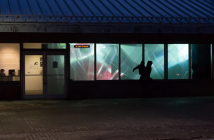Developments in technology and communication in recent decades, have lead to the evolution of new research methods in many fields. Increasingly, specialists have discovered that when they collaborate, or appropriate the tools of another discipline, they can uncover new information. Biologists at MIT have worked with advanced visual practitioners to find more effective ways to represent their research, and artists practicing critical cartography, have successfully employed research methods from geography in order to comment on a wide variety of social trends, to name just two examples.
Simultaneously, technological advances have led to the evolution of new forms–think of cell phone novels and blogs, to limit consideration to the literary field (within the sciences alone, this list might be interminable).
A spirit of interdisciplinarity and adaptability might be said to characterize many of the brightest thinkers of our time, who are intellectually agile and technologically connected-- poised to capture potential opportunities for collaboration, and opportunities for innovation.
Axiom's current exhibit, Pulling Back the Curtain, is a group show on the Green Street T stop in Jamaica Plain. This is Axiom's third home in five years and the gentle rumble of passing trains under the gallery floor in this latest location seems strangely apt—a subtle reminder of movement and continual change.
Pulling Back the Curtain was curated by by George Fifield, media arts curator, and Heidi Kayser, Axiom’s founding director. The exhibit features work by eleven artists in a variety of media ranging from film to mechanized sculpture and aims to explore ideas of perception, and the effects of nostalgia. The title serves as a good analogy for the show–giving a glimpse of the inner workings of what are usually seamless presentations of technology.
The exhibit is limited in scale, yet presents compelling, technocultural developments in art making–probing the tension between traditional fine art techniques and contemporary digital processes. Is there a place for using old aesthetics in new media? Must a new set of rules be invested for all new media, or does new media merely recycle old ways of seeing into a new package? Is new technology transparent in delivering content?
A piece by Nick Monfort, a professor at MIT and the author of numerous books on new media and electronic writing, makes this tension apparent. In ppg256-4, an LED display mounted on the wall publishes the ‘poetry’ generated by “perlpoetrygenerator256,” a computer program written by the artist. The poems, which are refreshed at regular intervals, are nonsensical and repetitive. The failure of the program to achieve the resonance of great poetry serves to highlight the significance of authorship and ultimately, at least to this observer’s eye, indicates the limits of objective correctness in writing. Writing is as much an object as it is a subject of culture, requiring our human limitations to form its content.
In Nostalgia for Neverwas, artist Joseph Farbrook illustrates the narrative of Casual Boy through a series of digitally generated photo-montages mounted inside an antique camera. Casual Boy is a computer generated character searching for a sense of deeper meaning in a time before technology (if there ever was a time before technology). Denied hidden truths in his own time, he becomes a time traveling arteur, invading archival images of pastoral life that he finds while roaming the internet and is seen playing checkers, running to catch a steam engine and wandering down a cobblestone street. Farbrook presents the rootless state that reflects a life of partial attention, and ruptures of history.
The exhibit and the artists it features are concerned not only with the loss of individuality, but also with the promise of technology to extend humanity. In a whimsical piece titled Credit Synthesis, Jonathon Vingiano invites viewers to swipe their credit cards in a scanner, which converts the magnetic information into lively musical slogans as a kind of corporate, musique concrète make-ready. In Cell Phone Painting #1, Vingiano stages a "networked performance of anonymous individuals" to create a painting. Text message commands are solicited by e-mail, and serve as instructions for a man who stands before a canvas. A time lapse video and the instructions themselves serve as a record of the event. This residue becomes the program by which the canvas could be re-run, though every human computer (the painter), would interpret this program differently. While each retains the essence of its medium to a degree, the inevitable blending among them is what is most exciting, letting our assumptions of both painting and texting lay bare, as if its creation was fostered by logic short circuit.
When Joseph Farbrook (in a piece entitled Flying in 2008 ) implicitly compares a view of a tarmac to a painting, and Nick Monfort (in ppg256-4), asks whether a computer programmer is, in fact, a sort of poet, the artists stretch and subvert our notions of what traditional media signify. Those who think painting was always traditional don't realize that oil paint was once modern marvel. These artists show something new about the quirks of their particular medium and create new presentations for what have become new ways to engage in our contemporary environment.
"Pulling Back the Curtain" is on view until September 27th at Axiom Gallery, located at 141 Green Street, Boston MA. All images are courtesy of the artists and Axiom.




